Holmes Institute T3 HA2022 Business Law: Contract Law Report
VerifiedAdded on 2022/08/31
|11
|2761
|19
Report
AI Summary
This report analyzes two contract law cases, addressing issues of promissory estoppel and negligence. Part A examines a scenario involving a letter of credit and the doctrine of promissory estoppel, determining the liability of the Bank of China. Part B delves into negligence cases: one concerning a car accident and the development of a malignant tumor, and another involving an employer's responsibility for employee injuries. The final case evaluates the liability of a thief for damages to a police car. The report applies the IRAC method (Issue, Rule, Application, Conclusion) to each case, citing relevant case laws and legal principles to support the analysis and conclusions. The report highlights key concepts such as causation, duty of care, and the extent of liability in different legal contexts.
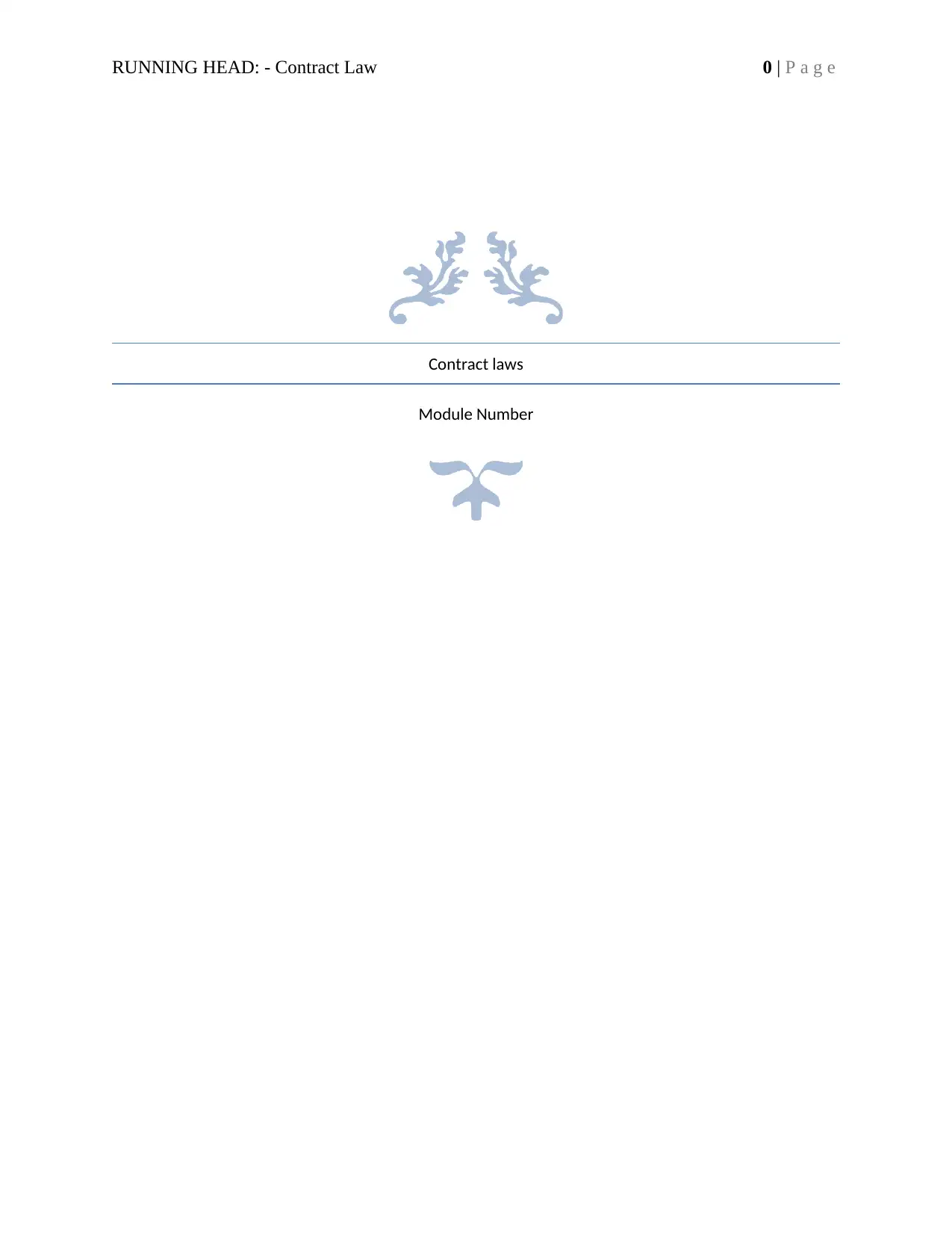
RUNNING HEAD: - Contract Law 0 | P a g e
Contract laws
Module Number
Contract laws
Module Number
Paraphrase This Document
Need a fresh take? Get an instant paraphrase of this document with our AI Paraphraser
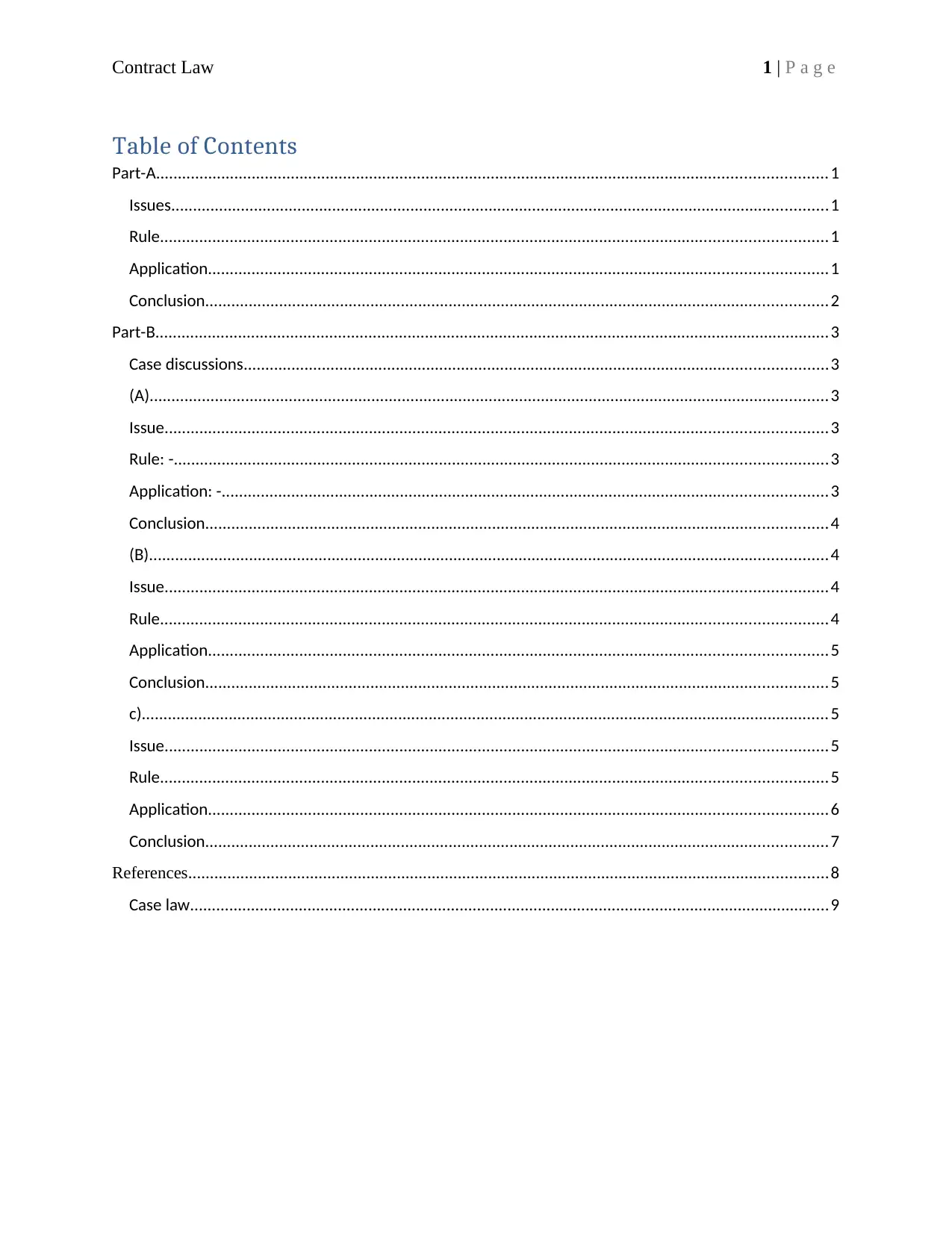
Contract Law 1 | P a g e
Table of Contents
Part-A..........................................................................................................................................................1
Issues.......................................................................................................................................................1
Rule.........................................................................................................................................................1
Application..............................................................................................................................................1
Conclusion...............................................................................................................................................2
Part-B...........................................................................................................................................................3
Case discussions......................................................................................................................................3
(A)............................................................................................................................................................3
Issue........................................................................................................................................................3
Rule: -......................................................................................................................................................3
Application: -...........................................................................................................................................3
Conclusion...............................................................................................................................................4
(B)............................................................................................................................................................4
Issue........................................................................................................................................................4
Rule.........................................................................................................................................................4
Application..............................................................................................................................................5
Conclusion...............................................................................................................................................5
c)..............................................................................................................................................................5
Issue........................................................................................................................................................5
Rule.........................................................................................................................................................5
Application..............................................................................................................................................6
Conclusion...............................................................................................................................................7
References...................................................................................................................................................8
Case law...................................................................................................................................................9
Table of Contents
Part-A..........................................................................................................................................................1
Issues.......................................................................................................................................................1
Rule.........................................................................................................................................................1
Application..............................................................................................................................................1
Conclusion...............................................................................................................................................2
Part-B...........................................................................................................................................................3
Case discussions......................................................................................................................................3
(A)............................................................................................................................................................3
Issue........................................................................................................................................................3
Rule: -......................................................................................................................................................3
Application: -...........................................................................................................................................3
Conclusion...............................................................................................................................................4
(B)............................................................................................................................................................4
Issue........................................................................................................................................................4
Rule.........................................................................................................................................................4
Application..............................................................................................................................................5
Conclusion...............................................................................................................................................5
c)..............................................................................................................................................................5
Issue........................................................................................................................................................5
Rule.........................................................................................................................................................5
Application..............................................................................................................................................6
Conclusion...............................................................................................................................................7
References...................................................................................................................................................8
Case law...................................................................................................................................................9
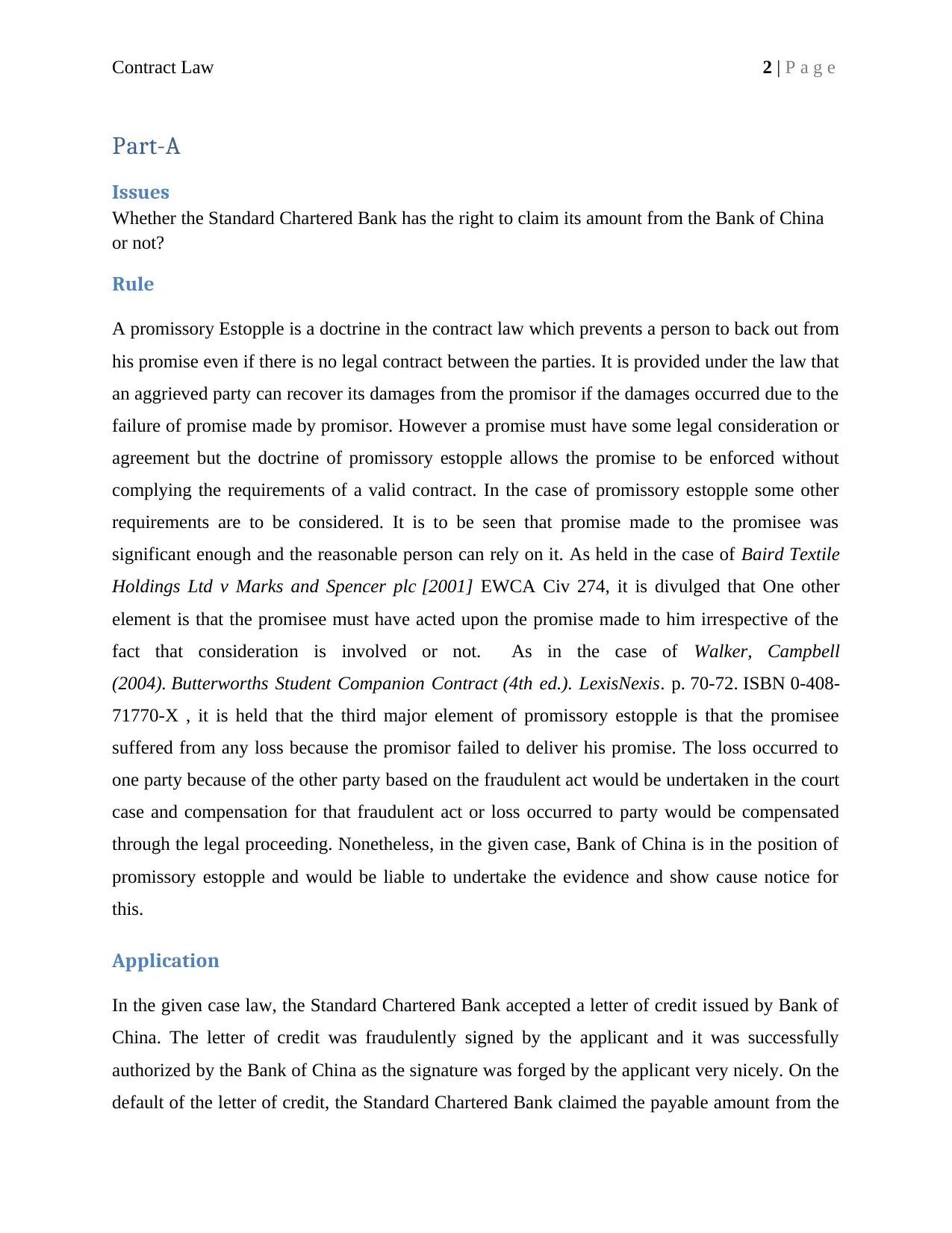
Contract Law 2 | P a g e
Part-A
Issues
Whether the Standard Chartered Bank has the right to claim its amount from the Bank of China
or not?
Rule
A promissory Estopple is a doctrine in the contract law which prevents a person to back out from
his promise even if there is no legal contract between the parties. It is provided under the law that
an aggrieved party can recover its damages from the promisor if the damages occurred due to the
failure of promise made by promisor. However a promise must have some legal consideration or
agreement but the doctrine of promissory estopple allows the promise to be enforced without
complying the requirements of a valid contract. In the case of promissory estopple some other
requirements are to be considered. It is to be seen that promise made to the promisee was
significant enough and the reasonable person can rely on it. As held in the case of Baird Textile
Holdings Ltd v Marks and Spencer plc [2001] EWCA Civ 274, it is divulged that One other
element is that the promisee must have acted upon the promise made to him irrespective of the
fact that consideration is involved or not. As in the case of Walker, Campbell
(2004). Butterworths Student Companion Contract (4th ed.). LexisNexis. p. 70-72. ISBN 0-408-
71770-X , it is held that the third major element of promissory estopple is that the promisee
suffered from any loss because the promisor failed to deliver his promise. The loss occurred to
one party because of the other party based on the fraudulent act would be undertaken in the court
case and compensation for that fraudulent act or loss occurred to party would be compensated
through the legal proceeding. Nonetheless, in the given case, Bank of China is in the position of
promissory estopple and would be liable to undertake the evidence and show cause notice for
this.
Application
In the given case law, the Standard Chartered Bank accepted a letter of credit issued by Bank of
China. The letter of credit was fraudulently signed by the applicant and it was successfully
authorized by the Bank of China as the signature was forged by the applicant very nicely. On the
default of the letter of credit, the Standard Chartered Bank claimed the payable amount from the
Part-A
Issues
Whether the Standard Chartered Bank has the right to claim its amount from the Bank of China
or not?
Rule
A promissory Estopple is a doctrine in the contract law which prevents a person to back out from
his promise even if there is no legal contract between the parties. It is provided under the law that
an aggrieved party can recover its damages from the promisor if the damages occurred due to the
failure of promise made by promisor. However a promise must have some legal consideration or
agreement but the doctrine of promissory estopple allows the promise to be enforced without
complying the requirements of a valid contract. In the case of promissory estopple some other
requirements are to be considered. It is to be seen that promise made to the promisee was
significant enough and the reasonable person can rely on it. As held in the case of Baird Textile
Holdings Ltd v Marks and Spencer plc [2001] EWCA Civ 274, it is divulged that One other
element is that the promisee must have acted upon the promise made to him irrespective of the
fact that consideration is involved or not. As in the case of Walker, Campbell
(2004). Butterworths Student Companion Contract (4th ed.). LexisNexis. p. 70-72. ISBN 0-408-
71770-X , it is held that the third major element of promissory estopple is that the promisee
suffered from any loss because the promisor failed to deliver his promise. The loss occurred to
one party because of the other party based on the fraudulent act would be undertaken in the court
case and compensation for that fraudulent act or loss occurred to party would be compensated
through the legal proceeding. Nonetheless, in the given case, Bank of China is in the position of
promissory estopple and would be liable to undertake the evidence and show cause notice for
this.
Application
In the given case law, the Standard Chartered Bank accepted a letter of credit issued by Bank of
China. The letter of credit was fraudulently signed by the applicant and it was successfully
authorized by the Bank of China as the signature was forged by the applicant very nicely. On the
default of the letter of credit, the Standard Chartered Bank claimed the payable amount from the
⊘ This is a preview!⊘
Do you want full access?
Subscribe today to unlock all pages.

Trusted by 1+ million students worldwide
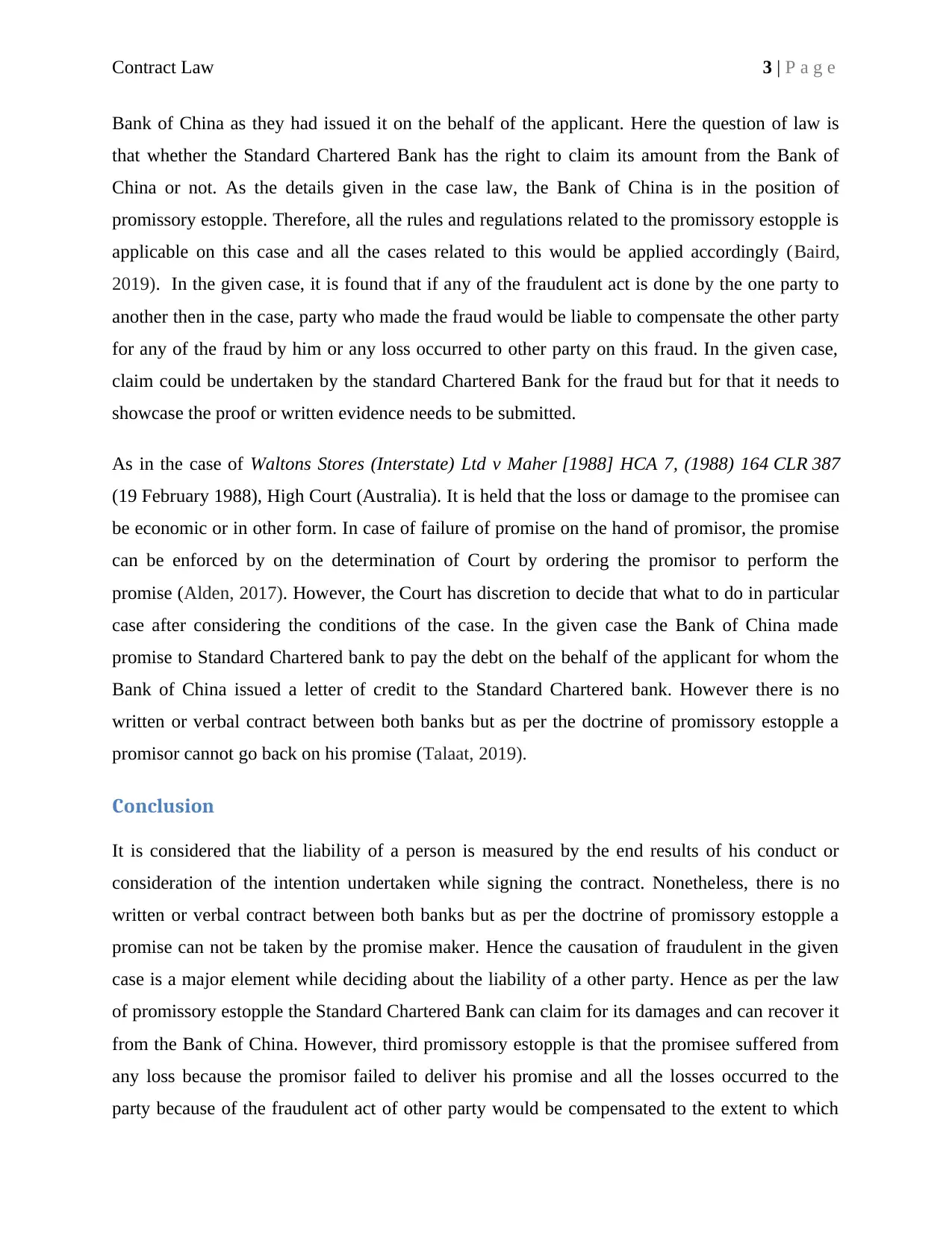
Contract Law 3 | P a g e
Bank of China as they had issued it on the behalf of the applicant. Here the question of law is
that whether the Standard Chartered Bank has the right to claim its amount from the Bank of
China or not. As the details given in the case law, the Bank of China is in the position of
promissory estopple. Therefore, all the rules and regulations related to the promissory estopple is
applicable on this case and all the cases related to this would be applied accordingly (Baird,
2019). In the given case, it is found that if any of the fraudulent act is done by the one party to
another then in the case, party who made the fraud would be liable to compensate the other party
for any of the fraud by him or any loss occurred to other party on this fraud. In the given case,
claim could be undertaken by the standard Chartered Bank for the fraud but for that it needs to
showcase the proof or written evidence needs to be submitted.
As in the case of Waltons Stores (Interstate) Ltd v Maher [1988] HCA 7, (1988) 164 CLR 387
(19 February 1988), High Court (Australia). It is held that the loss or damage to the promisee can
be economic or in other form. In case of failure of promise on the hand of promisor, the promise
can be enforced by on the determination of Court by ordering the promisor to perform the
promise (Alden, 2017). However, the Court has discretion to decide that what to do in particular
case after considering the conditions of the case. In the given case the Bank of China made
promise to Standard Chartered bank to pay the debt on the behalf of the applicant for whom the
Bank of China issued a letter of credit to the Standard Chartered bank. However there is no
written or verbal contract between both banks but as per the doctrine of promissory estopple a
promisor cannot go back on his promise (Talaat, 2019).
Conclusion
It is considered that the liability of a person is measured by the end results of his conduct or
consideration of the intention undertaken while signing the contract. Nonetheless, there is no
written or verbal contract between both banks but as per the doctrine of promissory estopple a
promise can not be taken by the promise maker. Hence the causation of fraudulent in the given
case is a major element while deciding about the liability of a other party. Hence as per the law
of promissory estopple the Standard Chartered Bank can claim for its damages and can recover it
from the Bank of China. However, third promissory estopple is that the promisee suffered from
any loss because the promisor failed to deliver his promise and all the losses occurred to the
party because of the fraudulent act of other party would be compensated to the extent to which
Bank of China as they had issued it on the behalf of the applicant. Here the question of law is
that whether the Standard Chartered Bank has the right to claim its amount from the Bank of
China or not. As the details given in the case law, the Bank of China is in the position of
promissory estopple. Therefore, all the rules and regulations related to the promissory estopple is
applicable on this case and all the cases related to this would be applied accordingly (Baird,
2019). In the given case, it is found that if any of the fraudulent act is done by the one party to
another then in the case, party who made the fraud would be liable to compensate the other party
for any of the fraud by him or any loss occurred to other party on this fraud. In the given case,
claim could be undertaken by the standard Chartered Bank for the fraud but for that it needs to
showcase the proof or written evidence needs to be submitted.
As in the case of Waltons Stores (Interstate) Ltd v Maher [1988] HCA 7, (1988) 164 CLR 387
(19 February 1988), High Court (Australia). It is held that the loss or damage to the promisee can
be economic or in other form. In case of failure of promise on the hand of promisor, the promise
can be enforced by on the determination of Court by ordering the promisor to perform the
promise (Alden, 2017). However, the Court has discretion to decide that what to do in particular
case after considering the conditions of the case. In the given case the Bank of China made
promise to Standard Chartered bank to pay the debt on the behalf of the applicant for whom the
Bank of China issued a letter of credit to the Standard Chartered bank. However there is no
written or verbal contract between both banks but as per the doctrine of promissory estopple a
promisor cannot go back on his promise (Talaat, 2019).
Conclusion
It is considered that the liability of a person is measured by the end results of his conduct or
consideration of the intention undertaken while signing the contract. Nonetheless, there is no
written or verbal contract between both banks but as per the doctrine of promissory estopple a
promise can not be taken by the promise maker. Hence the causation of fraudulent in the given
case is a major element while deciding about the liability of a other party. Hence as per the law
of promissory estopple the Standard Chartered Bank can claim for its damages and can recover it
from the Bank of China. However, third promissory estopple is that the promisee suffered from
any loss because the promisor failed to deliver his promise and all the losses occurred to the
party because of the fraudulent act of other party would be compensated to the extent to which
Paraphrase This Document
Need a fresh take? Get an instant paraphrase of this document with our AI Paraphraser
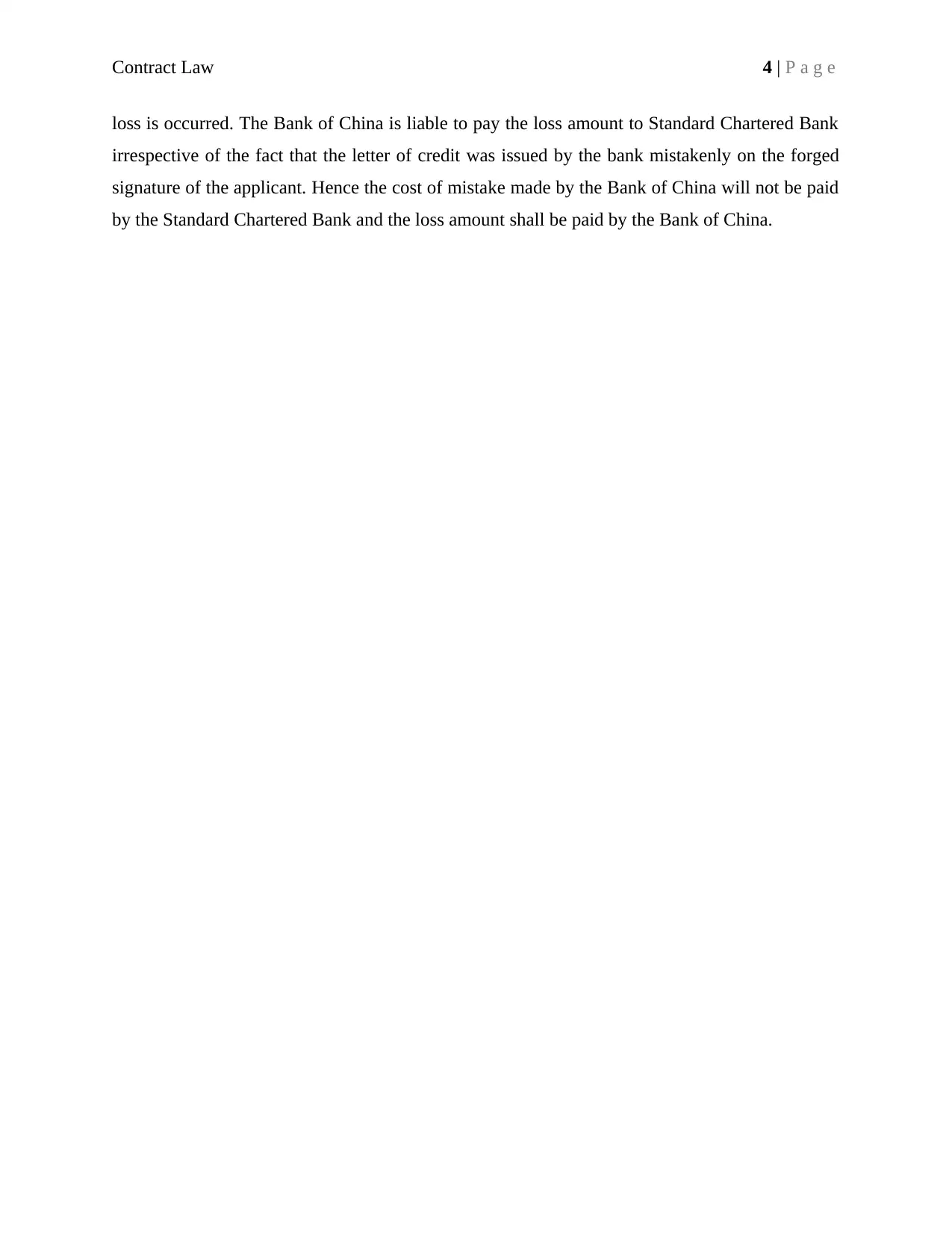
Contract Law 4 | P a g e
loss is occurred. The Bank of China is liable to pay the loss amount to Standard Chartered Bank
irrespective of the fact that the letter of credit was issued by the bank mistakenly on the forged
signature of the applicant. Hence the cost of mistake made by the Bank of China will not be paid
by the Standard Chartered Bank and the loss amount shall be paid by the Bank of China.
loss is occurred. The Bank of China is liable to pay the loss amount to Standard Chartered Bank
irrespective of the fact that the letter of credit was issued by the bank mistakenly on the forged
signature of the applicant. Hence the cost of mistake made by the Bank of China will not be paid
by the Standard Chartered Bank and the loss amount shall be paid by the Bank of China.
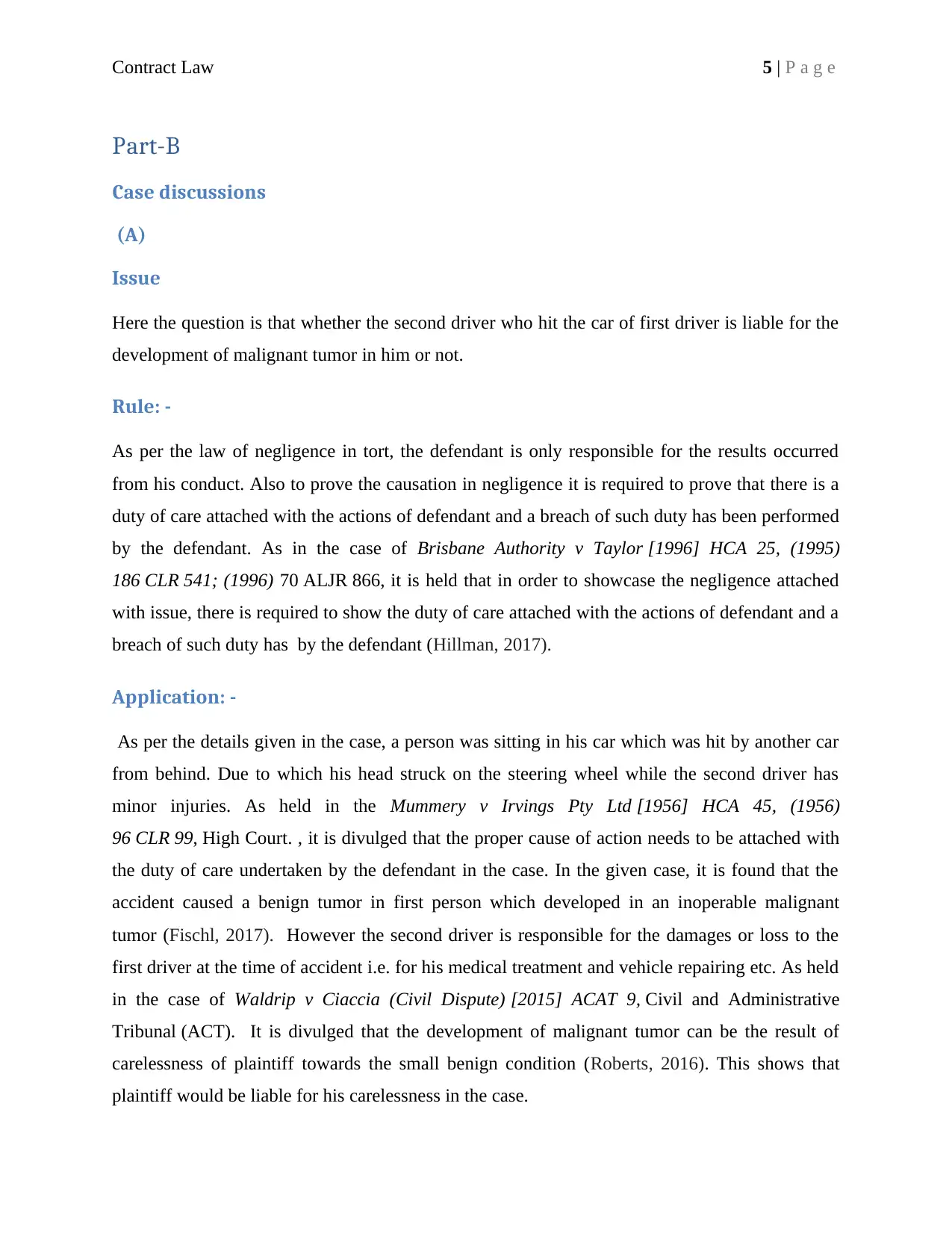
Contract Law 5 | P a g e
Part-B
Case discussions
(A)
Issue
Here the question is that whether the second driver who hit the car of first driver is liable for the
development of malignant tumor in him or not.
Rule: -
As per the law of negligence in tort, the defendant is only responsible for the results occurred
from his conduct. Also to prove the causation in negligence it is required to prove that there is a
duty of care attached with the actions of defendant and a breach of such duty has been performed
by the defendant. As in the case of Brisbane Authority v Taylor [1996] HCA 25, (1995)
186 CLR 541; (1996) 70 ALJR 866, it is held that in order to showcase the negligence attached
with issue, there is required to show the duty of care attached with the actions of defendant and a
breach of such duty has by the defendant (Hillman, 2017).
Application: -
As per the details given in the case, a person was sitting in his car which was hit by another car
from behind. Due to which his head struck on the steering wheel while the second driver has
minor injuries. As held in the Mummery v Irvings Pty Ltd [1956] HCA 45, (1956)
96 CLR 99, High Court. , it is divulged that the proper cause of action needs to be attached with
the duty of care undertaken by the defendant in the case. In the given case, it is found that the
accident caused a benign tumor in first person which developed in an inoperable malignant
tumor (Fischl, 2017). However the second driver is responsible for the damages or loss to the
first driver at the time of accident i.e. for his medical treatment and vehicle repairing etc. As held
in the case of Waldrip v Ciaccia (Civil Dispute) [2015] ACAT 9, Civil and Administrative
Tribunal (ACT). It is divulged that the development of malignant tumor can be the result of
carelessness of plaintiff towards the small benign condition (Roberts, 2016). This shows that
plaintiff would be liable for his carelessness in the case.
Part-B
Case discussions
(A)
Issue
Here the question is that whether the second driver who hit the car of first driver is liable for the
development of malignant tumor in him or not.
Rule: -
As per the law of negligence in tort, the defendant is only responsible for the results occurred
from his conduct. Also to prove the causation in negligence it is required to prove that there is a
duty of care attached with the actions of defendant and a breach of such duty has been performed
by the defendant. As in the case of Brisbane Authority v Taylor [1996] HCA 25, (1995)
186 CLR 541; (1996) 70 ALJR 866, it is held that in order to showcase the negligence attached
with issue, there is required to show the duty of care attached with the actions of defendant and a
breach of such duty has by the defendant (Hillman, 2017).
Application: -
As per the details given in the case, a person was sitting in his car which was hit by another car
from behind. Due to which his head struck on the steering wheel while the second driver has
minor injuries. As held in the Mummery v Irvings Pty Ltd [1956] HCA 45, (1956)
96 CLR 99, High Court. , it is divulged that the proper cause of action needs to be attached with
the duty of care undertaken by the defendant in the case. In the given case, it is found that the
accident caused a benign tumor in first person which developed in an inoperable malignant
tumor (Fischl, 2017). However the second driver is responsible for the damages or loss to the
first driver at the time of accident i.e. for his medical treatment and vehicle repairing etc. As held
in the case of Waldrip v Ciaccia (Civil Dispute) [2015] ACAT 9, Civil and Administrative
Tribunal (ACT). It is divulged that the development of malignant tumor can be the result of
carelessness of plaintiff towards the small benign condition (Roberts, 2016). This shows that
plaintiff would be liable for his carelessness in the case.
⊘ This is a preview!⊘
Do you want full access?
Subscribe today to unlock all pages.

Trusted by 1+ million students worldwide
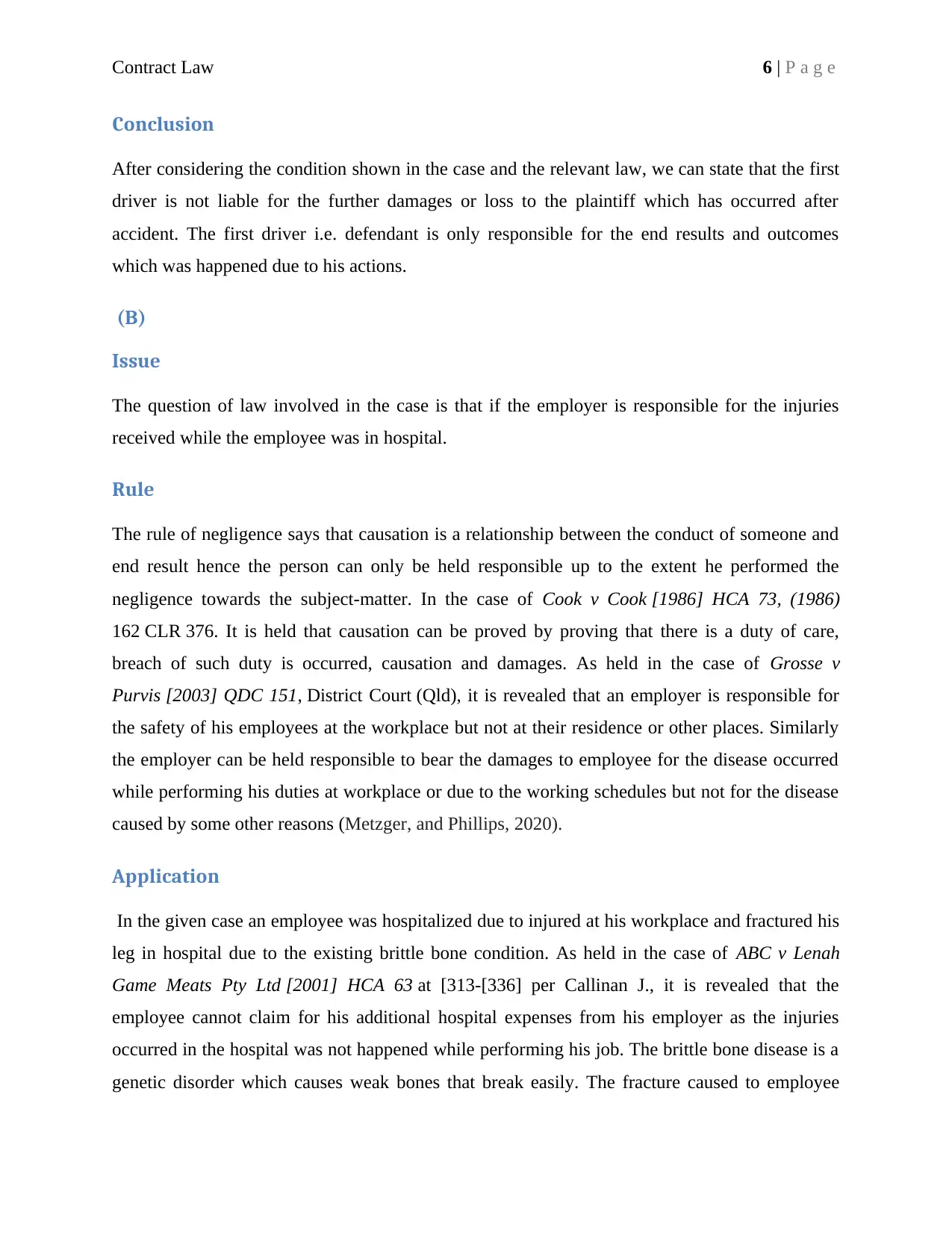
Contract Law 6 | P a g e
Conclusion
After considering the condition shown in the case and the relevant law, we can state that the first
driver is not liable for the further damages or loss to the plaintiff which has occurred after
accident. The first driver i.e. defendant is only responsible for the end results and outcomes
which was happened due to his actions.
(B)
Issue
The question of law involved in the case is that if the employer is responsible for the injuries
received while the employee was in hospital.
Rule
The rule of negligence says that causation is a relationship between the conduct of someone and
end result hence the person can only be held responsible up to the extent he performed the
negligence towards the subject-matter. In the case of Cook v Cook [1986] HCA 73, (1986)
162 CLR 376. It is held that causation can be proved by proving that there is a duty of care,
breach of such duty is occurred, causation and damages. As held in the case of Grosse v
Purvis [2003] QDC 151, District Court (Qld), it is revealed that an employer is responsible for
the safety of his employees at the workplace but not at their residence or other places. Similarly
the employer can be held responsible to bear the damages to employee for the disease occurred
while performing his duties at workplace or due to the working schedules but not for the disease
caused by some other reasons (Metzger, and Phillips, 2020).
Application
In the given case an employee was hospitalized due to injured at his workplace and fractured his
leg in hospital due to the existing brittle bone condition. As held in the case of ABC v Lenah
Game Meats Pty Ltd [2001] HCA 63 at [313-[336] per Callinan J., it is revealed that the
employee cannot claim for his additional hospital expenses from his employer as the injuries
occurred in the hospital was not happened while performing his job. The brittle bone disease is a
genetic disorder which causes weak bones that break easily. The fracture caused to employee
Conclusion
After considering the condition shown in the case and the relevant law, we can state that the first
driver is not liable for the further damages or loss to the plaintiff which has occurred after
accident. The first driver i.e. defendant is only responsible for the end results and outcomes
which was happened due to his actions.
(B)
Issue
The question of law involved in the case is that if the employer is responsible for the injuries
received while the employee was in hospital.
Rule
The rule of negligence says that causation is a relationship between the conduct of someone and
end result hence the person can only be held responsible up to the extent he performed the
negligence towards the subject-matter. In the case of Cook v Cook [1986] HCA 73, (1986)
162 CLR 376. It is held that causation can be proved by proving that there is a duty of care,
breach of such duty is occurred, causation and damages. As held in the case of Grosse v
Purvis [2003] QDC 151, District Court (Qld), it is revealed that an employer is responsible for
the safety of his employees at the workplace but not at their residence or other places. Similarly
the employer can be held responsible to bear the damages to employee for the disease occurred
while performing his duties at workplace or due to the working schedules but not for the disease
caused by some other reasons (Metzger, and Phillips, 2020).
Application
In the given case an employee was hospitalized due to injured at his workplace and fractured his
leg in hospital due to the existing brittle bone condition. As held in the case of ABC v Lenah
Game Meats Pty Ltd [2001] HCA 63 at [313-[336] per Callinan J., it is revealed that the
employee cannot claim for his additional hospital expenses from his employer as the injuries
occurred in the hospital was not happened while performing his job. The brittle bone disease is a
genetic disorder which causes weak bones that break easily. The fracture caused to employee
Paraphrase This Document
Need a fresh take? Get an instant paraphrase of this document with our AI Paraphraser
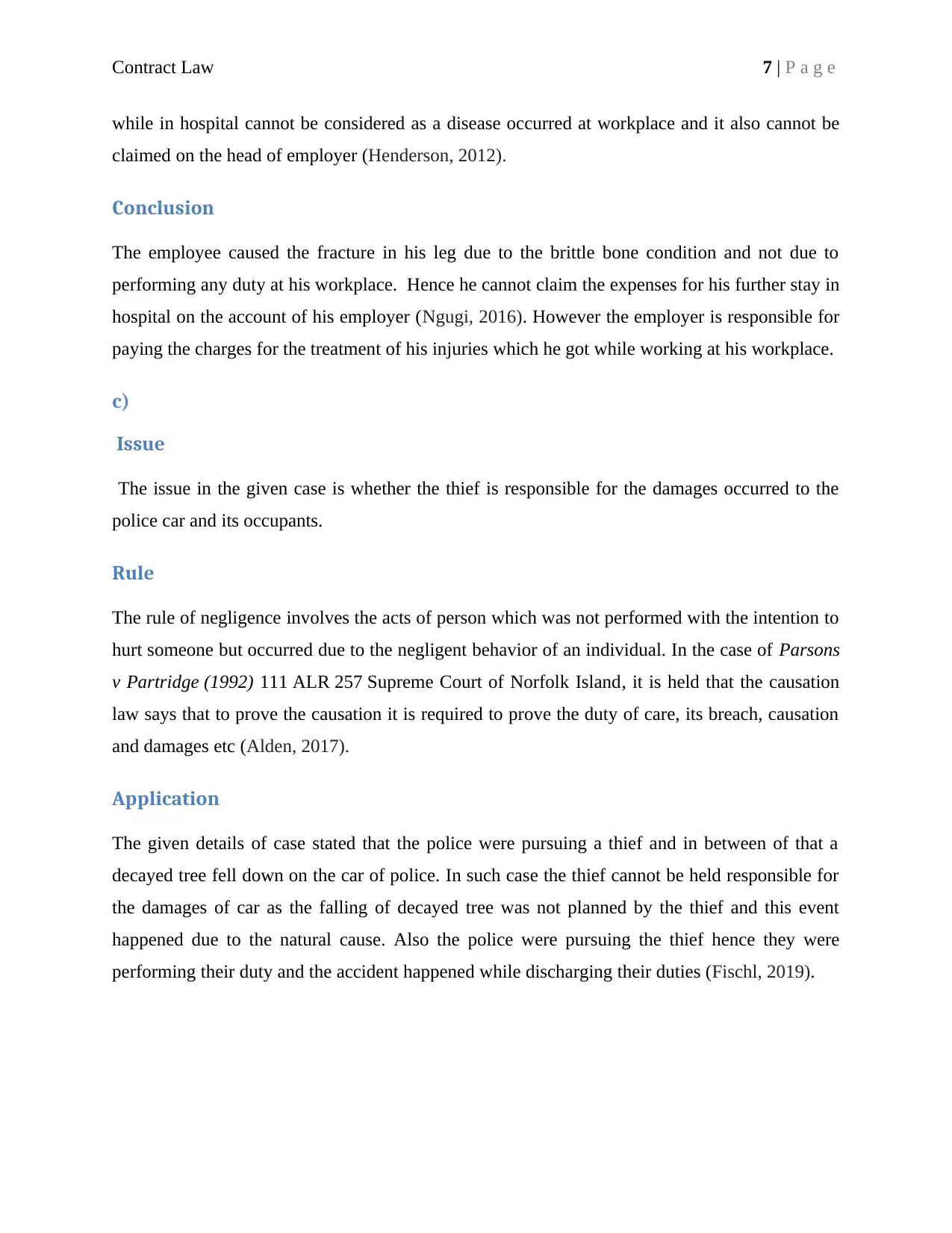
Contract Law 7 | P a g e
while in hospital cannot be considered as a disease occurred at workplace and it also cannot be
claimed on the head of employer (Henderson, 2012).
Conclusion
The employee caused the fracture in his leg due to the brittle bone condition and not due to
performing any duty at his workplace. Hence he cannot claim the expenses for his further stay in
hospital on the account of his employer (Ngugi, 2016). However the employer is responsible for
paying the charges for the treatment of his injuries which he got while working at his workplace.
c)
Issue
The issue in the given case is whether the thief is responsible for the damages occurred to the
police car and its occupants.
Rule
The rule of negligence involves the acts of person which was not performed with the intention to
hurt someone but occurred due to the negligent behavior of an individual. In the case of Parsons
v Partridge (1992) 111 ALR 257 Supreme Court of Norfolk Island, it is held that the causation
law says that to prove the causation it is required to prove the duty of care, its breach, causation
and damages etc (Alden, 2017).
Application
The given details of case stated that the police were pursuing a thief and in between of that a
decayed tree fell down on the car of police. In such case the thief cannot be held responsible for
the damages of car as the falling of decayed tree was not planned by the thief and this event
happened due to the natural cause. Also the police were pursuing the thief hence they were
performing their duty and the accident happened while discharging their duties (Fischl, 2019).
while in hospital cannot be considered as a disease occurred at workplace and it also cannot be
claimed on the head of employer (Henderson, 2012).
Conclusion
The employee caused the fracture in his leg due to the brittle bone condition and not due to
performing any duty at his workplace. Hence he cannot claim the expenses for his further stay in
hospital on the account of his employer (Ngugi, 2016). However the employer is responsible for
paying the charges for the treatment of his injuries which he got while working at his workplace.
c)
Issue
The issue in the given case is whether the thief is responsible for the damages occurred to the
police car and its occupants.
Rule
The rule of negligence involves the acts of person which was not performed with the intention to
hurt someone but occurred due to the negligent behavior of an individual. In the case of Parsons
v Partridge (1992) 111 ALR 257 Supreme Court of Norfolk Island, it is held that the causation
law says that to prove the causation it is required to prove the duty of care, its breach, causation
and damages etc (Alden, 2017).
Application
The given details of case stated that the police were pursuing a thief and in between of that a
decayed tree fell down on the car of police. In such case the thief cannot be held responsible for
the damages of car as the falling of decayed tree was not planned by the thief and this event
happened due to the natural cause. Also the police were pursuing the thief hence they were
performing their duty and the accident happened while discharging their duties (Fischl, 2019).
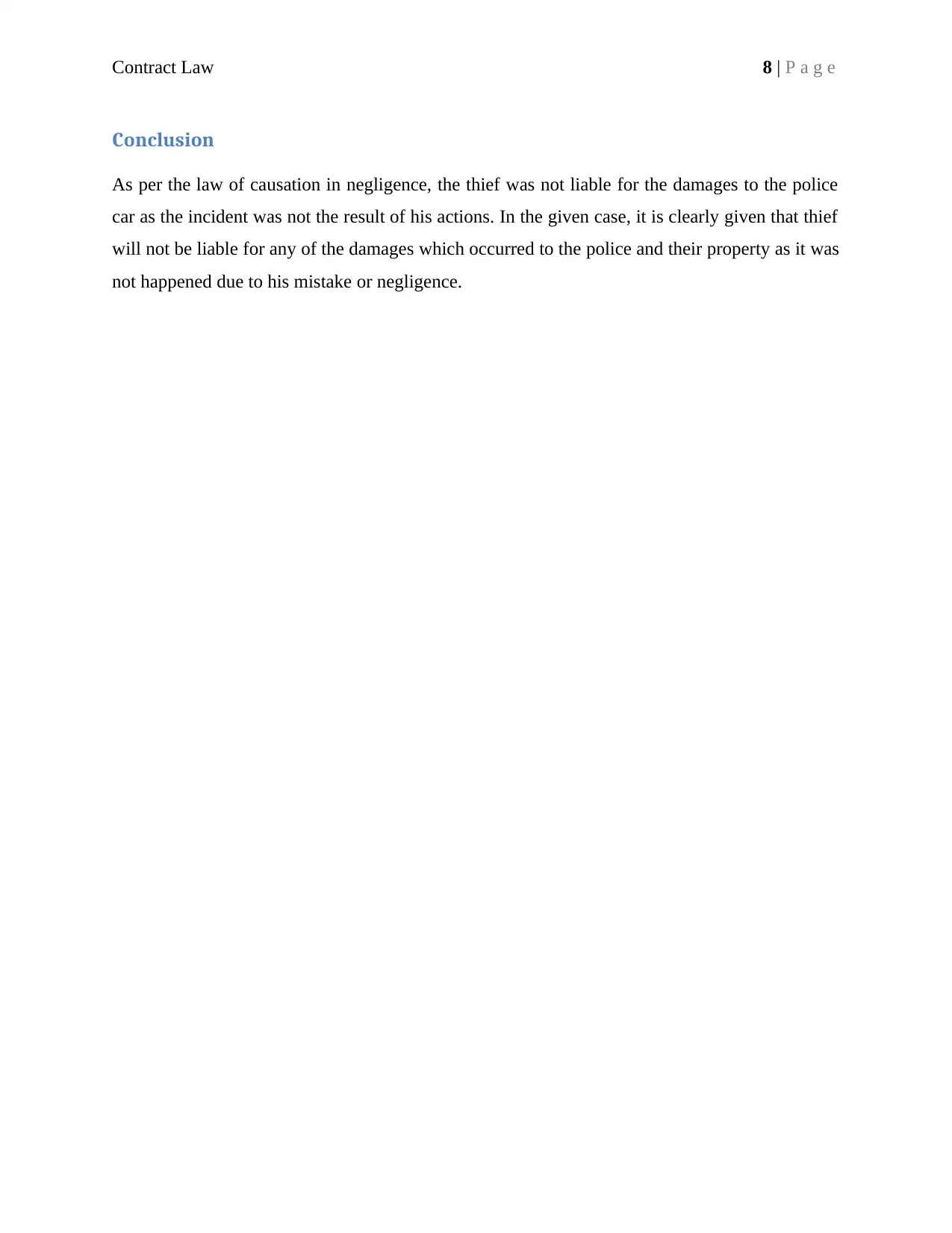
Contract Law 8 | P a g e
Conclusion
As per the law of causation in negligence, the thief was not liable for the damages to the police
car as the incident was not the result of his actions. In the given case, it is clearly given that thief
will not be liable for any of the damages which occurred to the police and their property as it was
not happened due to his mistake or negligence.
Conclusion
As per the law of causation in negligence, the thief was not liable for the damages to the police
car as the incident was not the result of his actions. In the given case, it is clearly given that thief
will not be liable for any of the damages which occurred to the police and their property as it was
not happened due to his mistake or negligence.
⊘ This is a preview!⊘
Do you want full access?
Subscribe today to unlock all pages.

Trusted by 1+ million students worldwide
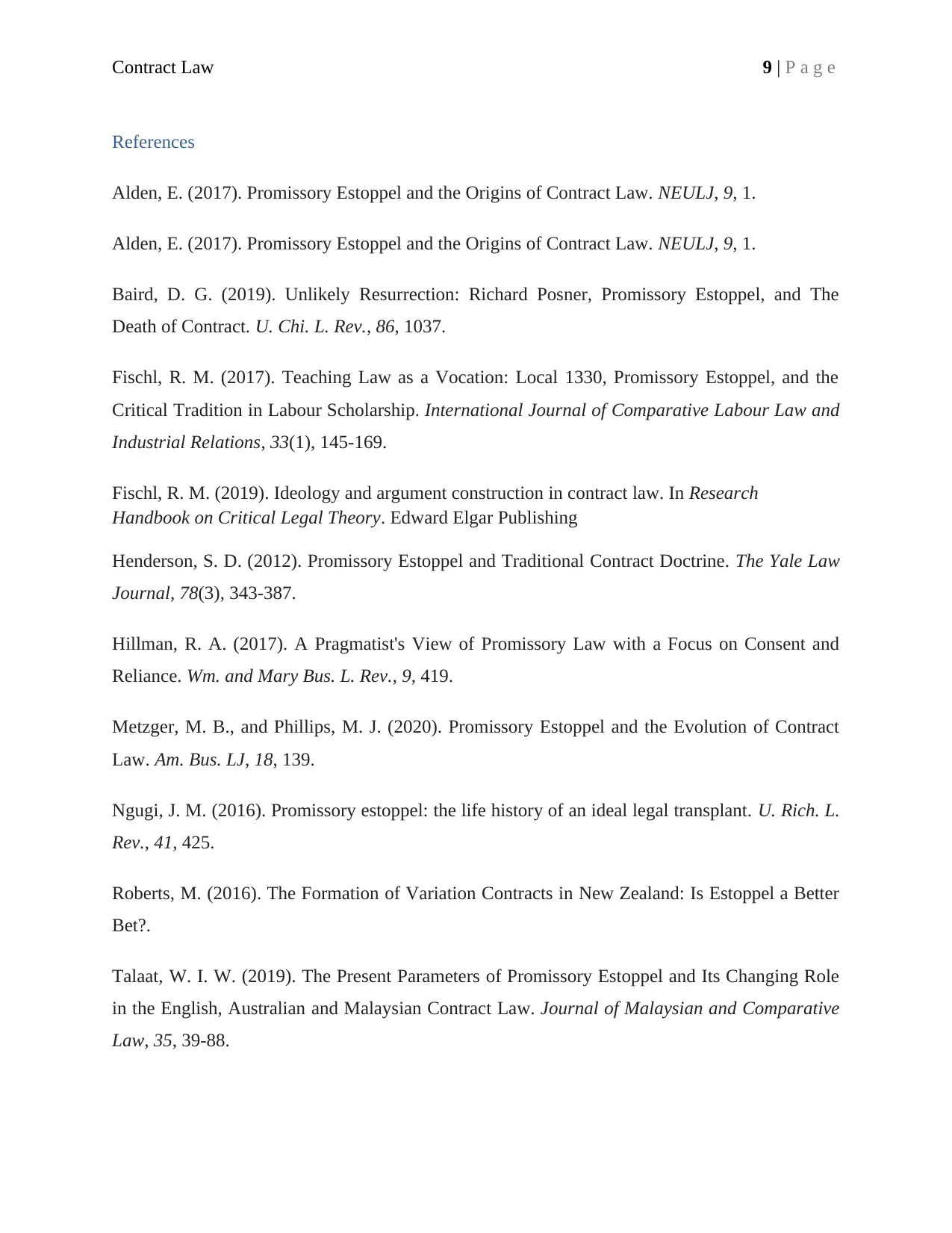
Contract Law 9 | P a g e
References
Alden, E. (2017). Promissory Estoppel and the Origins of Contract Law. NEULJ, 9, 1.
Alden, E. (2017). Promissory Estoppel and the Origins of Contract Law. NEULJ, 9, 1.
Baird, D. G. (2019). Unlikely Resurrection: Richard Posner, Promissory Estoppel, and The
Death of Contract. U. Chi. L. Rev., 86, 1037.
Fischl, R. M. (2017). Teaching Law as a Vocation: Local 1330, Promissory Estoppel, and the
Critical Tradition in Labour Scholarship. International Journal of Comparative Labour Law and
Industrial Relations, 33(1), 145-169.
Fischl, R. M. (2019). Ideology and argument construction in contract law. In Research
Handbook on Critical Legal Theory. Edward Elgar Publishing
Henderson, S. D. (2012). Promissory Estoppel and Traditional Contract Doctrine. The Yale Law
Journal, 78(3), 343-387.
Hillman, R. A. (2017). A Pragmatist's View of Promissory Law with a Focus on Consent and
Reliance. Wm. and Mary Bus. L. Rev., 9, 419.
Metzger, M. B., and Phillips, M. J. (2020). Promissory Estoppel and the Evolution of Contract
Law. Am. Bus. LJ, 18, 139.
Ngugi, J. M. (2016). Promissory estoppel: the life history of an ideal legal transplant. U. Rich. L.
Rev., 41, 425.
Roberts, M. (2016). The Formation of Variation Contracts in New Zealand: Is Estoppel a Better
Bet?.
Talaat, W. I. W. (2019). The Present Parameters of Promissory Estoppel and Its Changing Role
in the English, Australian and Malaysian Contract Law. Journal of Malaysian and Comparative
Law, 35, 39-88.
References
Alden, E. (2017). Promissory Estoppel and the Origins of Contract Law. NEULJ, 9, 1.
Alden, E. (2017). Promissory Estoppel and the Origins of Contract Law. NEULJ, 9, 1.
Baird, D. G. (2019). Unlikely Resurrection: Richard Posner, Promissory Estoppel, and The
Death of Contract. U. Chi. L. Rev., 86, 1037.
Fischl, R. M. (2017). Teaching Law as a Vocation: Local 1330, Promissory Estoppel, and the
Critical Tradition in Labour Scholarship. International Journal of Comparative Labour Law and
Industrial Relations, 33(1), 145-169.
Fischl, R. M. (2019). Ideology and argument construction in contract law. In Research
Handbook on Critical Legal Theory. Edward Elgar Publishing
Henderson, S. D. (2012). Promissory Estoppel and Traditional Contract Doctrine. The Yale Law
Journal, 78(3), 343-387.
Hillman, R. A. (2017). A Pragmatist's View of Promissory Law with a Focus on Consent and
Reliance. Wm. and Mary Bus. L. Rev., 9, 419.
Metzger, M. B., and Phillips, M. J. (2020). Promissory Estoppel and the Evolution of Contract
Law. Am. Bus. LJ, 18, 139.
Ngugi, J. M. (2016). Promissory estoppel: the life history of an ideal legal transplant. U. Rich. L.
Rev., 41, 425.
Roberts, M. (2016). The Formation of Variation Contracts in New Zealand: Is Estoppel a Better
Bet?.
Talaat, W. I. W. (2019). The Present Parameters of Promissory Estoppel and Its Changing Role
in the English, Australian and Malaysian Contract Law. Journal of Malaysian and Comparative
Law, 35, 39-88.
Paraphrase This Document
Need a fresh take? Get an instant paraphrase of this document with our AI Paraphraser
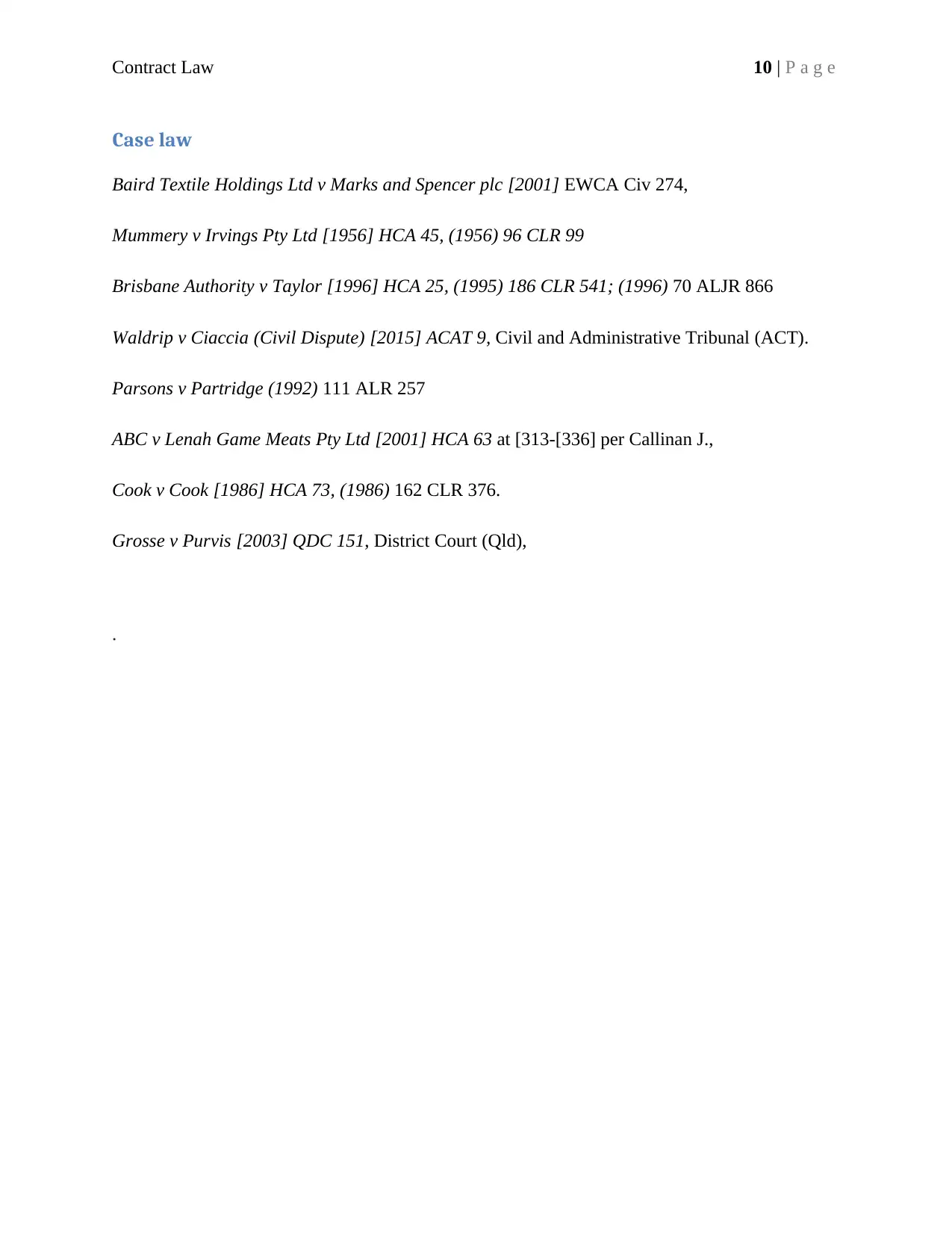
Contract Law 10 | P a g e
Case law
Baird Textile Holdings Ltd v Marks and Spencer plc [2001] EWCA Civ 274,
Mummery v Irvings Pty Ltd [1956] HCA 45, (1956) 96 CLR 99
Brisbane Authority v Taylor [1996] HCA 25, (1995) 186 CLR 541; (1996) 70 ALJR 866
Waldrip v Ciaccia (Civil Dispute) [2015] ACAT 9, Civil and Administrative Tribunal (ACT).
Parsons v Partridge (1992) 111 ALR 257
ABC v Lenah Game Meats Pty Ltd [2001] HCA 63 at [313-[336] per Callinan J.,
Cook v Cook [1986] HCA 73, (1986) 162 CLR 376.
Grosse v Purvis [2003] QDC 151, District Court (Qld),
.
Case law
Baird Textile Holdings Ltd v Marks and Spencer plc [2001] EWCA Civ 274,
Mummery v Irvings Pty Ltd [1956] HCA 45, (1956) 96 CLR 99
Brisbane Authority v Taylor [1996] HCA 25, (1995) 186 CLR 541; (1996) 70 ALJR 866
Waldrip v Ciaccia (Civil Dispute) [2015] ACAT 9, Civil and Administrative Tribunal (ACT).
Parsons v Partridge (1992) 111 ALR 257
ABC v Lenah Game Meats Pty Ltd [2001] HCA 63 at [313-[336] per Callinan J.,
Cook v Cook [1986] HCA 73, (1986) 162 CLR 376.
Grosse v Purvis [2003] QDC 151, District Court (Qld),
.
1 out of 11
Related Documents
Your All-in-One AI-Powered Toolkit for Academic Success.
+13062052269
info@desklib.com
Available 24*7 on WhatsApp / Email
![[object Object]](/_next/static/media/star-bottom.7253800d.svg)
Unlock your academic potential
Copyright © 2020–2025 A2Z Services. All Rights Reserved. Developed and managed by ZUCOL.





